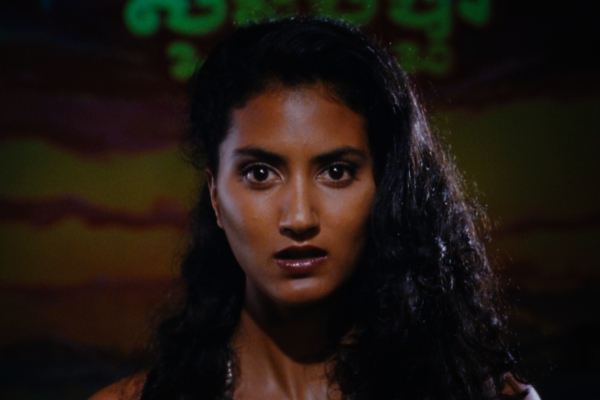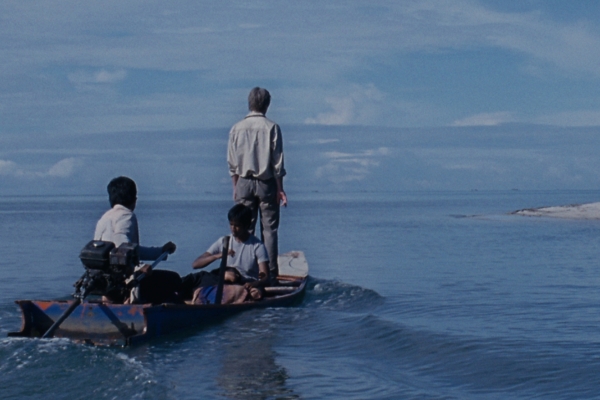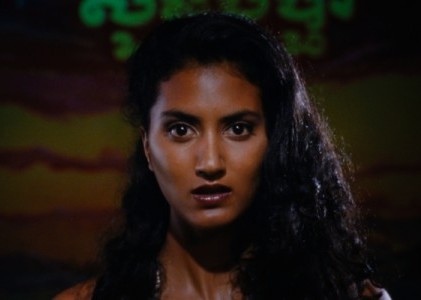Jungle Fever
To start the New Year, the Museum introduces First Look, a new annual showcase curated by Dennis Lim, Rachael Rakes, and David Schwartz. This two-weekend program—which brings together some of the most invigorating and inventive voices in contemporary world cinema, including established and emerging filmmakers—affirms our belief in cinema as a flourishing art form. To supplement the program, Moving Image Source is running a series of essays on all the feature films that are being shown. Check back daily from now through next weekend for new articles.
"When it is internalized, experience is given without speaking, transmitted as a spectral presence; you cannot separate yourself from it." —Chantal Akerman
Chantal Akerman's latest film and majestic return to fiction, Almayer's Folly (La folie Almayer), is a cunning mash-up of two sources, one literary opera prima, the other a cinematic swan song from one of the greatest filmmakers who ever lived. While the title explicitly evokes Joseph Conrad's first and rarely read novel, the film is, as its credits acknowledge, a liberal adaptation, and owes just as much to F.W. Murnau's final film, Tabu, which was co-conceived by legendary ethnographic filmmaker Robert Flaherty, and retains an aura of mystery, misfortune, and myth about it (superstitions flared after Murnau's fatal car crash during the film's post-production). Perhaps cocktail is a better metaphor than mash-up, one with a liberal pouring of Akerman's own auteurist motifs, incongruous though they may seem in a hazy, opium-scented jungle in Cambodia parading as colonial Malaysia. Little is done to ensure the accuracy of the film's location. We are in Akerman's well-worn but compulsively sensual terrain: the land of the oneiric, heavy as it is airy, with sodden humidity and leaden gestures, the weight and wantonness of utter desperation and inevitable earthly disappointment.
By Akerman's own account, one heart-rending chapter of Conrad from the very end of his novel (despondent Dutch master Kaspar Almayer on the cusp of forever losing his gorgeous half-caste daughter, Nina) and a spontaneous re-watching of Tabu (1931), with its uncanny echoes of Almayer's Folly (note the similar titular subtitles Almayer's Folly: A story of an eastern river and Tabu: a story of the south seas), commingled to produce a steamy, though staid and stylized, alchemical odyssey that trades in some of Akerman's characteristically bold idiosyncrasies and sly subversions.

Aurora Marion in Almayer's Folly
Just as Akerman bravely tackled Proust, subsuming as her own the fragile and fey writer's quotidian lethargies and erotic obsessions in the brilliant La Captive (2000), Almayer's Folly is an epic tale of greed, of love (and love lost) between a father and daughter, as well as another of the Belgian master's portraits of otherness (Lévinas loiters in the foliage), a study of confinement and constriction (by physical but also mental borders, where madness and traumatic memory are wont to prevail), and an exploration of blurry gender definitions and roles. The storytelling is superbly, even masterfully eccentric: cyclical, soporific, and strangely complex in its simplicity and dramatic waywardness. A film that demands to be seen twice, Almayer's grows ever more beguiling in its mystery as it ultimately remains haunted by the ambiguity of its post-colonial gaze and by the inscrutable expressionism of its lush and enveloping landscape. Like Tabu, the film harbors a talismanic power that transcends the plot points of its conflicted story. It's best to surrender and succumb to its mood, to its hushed prophecies and to the volatility of its environs, mimicked by its hotheaded characters.
A gripping opening scene, which ranks as one of Akerman's most arresting (and could conceivably have been plucked from Edward Yang's masterpiece, A Brighter Summer Day), depicts a tawdry, tacky-sexy lip-synching performance as a young, chisel-cheeked frontman in a sequined blazer mouths the words to Dean Martin's "Sway" while doing a corny hip-grind as scantily clad, long-tressed girls sway in unison behind him. A sad-eyed interloper steps onstage and calmly stabs the crooner in the chest, as the girls scamper and teeter offstage and offscreen in a panic, all except for a strong-featured, sinewy beauty who hypnotically continues her hula dance (from Tabu?) until the camera tracks in and frames the young woman in a portrait-style medium shot as she begins to belt out Mozart's Ave Verum, a Latin aria both mismatched and perfectly harmonious to the scene. The dead man, we later learn, was her lover Dain, the sketchy "native" enlisted to help her poor, pathetic father, Almayer (played with fierce and theatrical aplomb by an anemic and crazed-looking Stanislas Merhar, the lead from La Captive), find his ever-elusive treasure. But dashing Dain instead lures the half-Dutch, half-Malay Nina away from Almayer and his decrepit and depressing hovel of a trade-post barge, where the patriarch's dreams of striking it rich linger as passing figments and fleeting fantasies, an addiction far greater than the opium miasma that pervades his den.

Stanislas Merhar in Almayer's Folly
The bewildering, literal showstopper of a beginning is a flash-forward with a look and feel completely distinct from the rest of the film; a lurid-toned and culture-clashing requiem for a tale enmeshed in its own languid telling. As in both Conrad's novel and Tabu, the main action (mainly the minutiae-driven action of inaction that is Akerman's specialty) occurs on or near a tumultuous riverbed, a source of life and death, of hope and despair. Almayer's is a destiny damned by avarice and an unyielding sense of internalized racial superiority and entitlement. He's a white man who married a Malaysian woman solely for her inheritance, who grew increasingly obsessed with wealth and his return to Europe with his, not their daughter. Their wealth, his and Nina's, would whiten her skin to the eyes of the Europeans and they would lead a life of opulence and happiness. While Almayer's love for Nina may be true and all-consuming, deluded as much as denuded, it was tainted from the start, from the hatred and disgust he expressed toward his betelnut-eating Malaysian wife, whose adopted father, the enterprising once-rich colonialist Captain Lingard, chose Almayer to be her husband; with gold flecks in his eyes, the latter acquiesced to what he believed was a temporary sacrifice.
But the waters churned and a calamitous life unfolded for them all as pirogues quietly came and went: Lingard lost his fortune, the discarded wife went mad, and Almayer could do nothing but stew in his loss and pin all his dreams and expectations (and incestuous desire) on the tough and visibly torn teenaged Nina. Once Lingard dies and the money runs dry, Nina is banished from the European-run convent providing her Western education. It was only while money flowed that she was "one of us." That line is tersely delivered by an unseen nun behind a grilled door window in a brief passage reminiscent of Rivette's The Nun (La Religieuse) and The Duchess of Langeais (Ne Touchez pas la Hache), with an emphasis on cold confinement and self-abnegation. The gravelly voice, sec et rauque, is that of Akerman repeating a phrase she often heard her father pose as a question while she was growing up. "Is she, are they, one of us?" He meant Jewish, of course, and that cautious sentiment expressed in 1950s Europe, and here transposed to the same decade from Conrad's late 19th-century setting, is trenchant.
Nina is herself a Malaise. Ample and convenient wordplay abounds and she becomes the embodiment of lassitude, her ethnic identity bound to connotations of unease and tropical malady. Just like Almayer's folly, which is imperfectly translated from the French folie meaning madness or insanity, not folly, malaise becomes her; it oozes in her bloodstream like her father's madness courses through his. The proportions of Almayer's Folly are ultimately those of a Greek tragedy, with masks and rituals and the wrath of the gods. A torpor reigns upon the set, itself real and wild and pulsing with a mercurial life force captured exquisitely by documentarian d.p. Rémon Fremont, who has worked with Akerman on some of her best nonfiction films, Sud, D'Est, and De l'autre côté. Here the rhythms of life are pitted against the meaning of life—as in Tabu's storied split between Murnau and Flaherty's divergent sensibilities—but Akerman's oneiric lyricism defies a clichéd heart of darkness and instead rests upon, with great longueurs, our baleful human fallibility. With plangent residual anxiety, Akerman cannot help questioning the possibility for love and poetry in a world that has, more than once, condoned hell on earth. ![]()
LATEST ARTICLES
-20140814-173707-thumb3.jpg)
Fighting Words
by Imogen Sara Smith
posted August 12, 2014

Fighting Words, Part 2
by Imogen Sara Smith
posted August 20, 2014

On the Margins: The Fil…
by Andrew Chan
posted August 12, 2014

Robin Williams: A Sense…
by David Schwartz
posted August 12, 2014
 Jungle Fever
Jungle Fever
RELATED ARTICLE
Glass Houses by Michael SicinskiGoing the Distance by Scott MacDonald
Ghost World by Colin Beckett
Island Time by R. Emmet Sweeney
Darkness Doubled by Leo Goldsmith
Unplugged by Phil Coldiron
A Nude by Garrel by Eugenio Renzi
Twilight Zone by Robert Koehler
Family Viewing by Mark Peranson
Capitalist Punishment by Shelly Kraicer
Her Own Devices by Robert Koehler
The Fallen by Phil Coldiron
The 1 Percent Solution by Michael Sicinski
More: Article Archive
THE AUTHOR
Andréa Picard is a Toronto-based curator and writer who programs for the Toronto International Film Festival and writes a regular column for Cinema Scope magazine.
More articles by Andréa Picard
